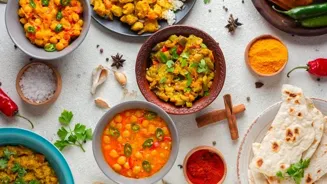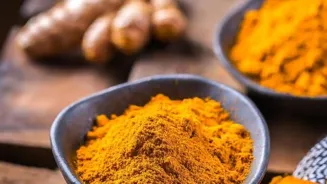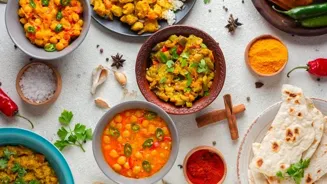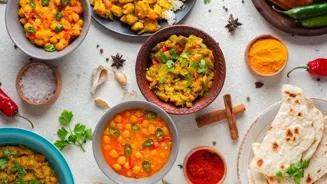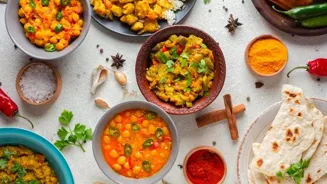Unveiling the Art of Balancing Sweet, Sour, and Spicy Flavors in Indian Cooking - Dive into the world of tantalizing tastes!
Indian cuisine, a kaleidoscope of tastes and aromas, is globally celebrated for
its intricate use of spices and the harmonious blend of sweet, sour, and spicy elements.
This balancing act is not merely about adding ingredients; it’s a sophisticated art form passed down through generations, transforming humble dishes into culinary masterpieces.
From the tangy sweetness of a Gujarati dal to the fiery yet refreshing notes of a South Indian sambar, the dance between these three primary flavors is central to the Indian food experience. Understanding this balance is the key to unlocking the true potential of Indian cooking.
It allows home cooks and chefs alike to create dishes that are both satisfying and complex, tantalizing the taste buds and leaving a lasting impression.
Balancing flavors in Indian cooking based on Ayurveda principles
The concept of balancing flavors in Indian cooking is deeply rooted in Ayurveda, the ancient Indian system of medicine.
Ayurveda emphasizes the importance of consuming foods that incorporate all six tastes – sweet, sour, salty, bitter, pungent, and astringent – in a balanced manner to maintain physical and mental well-being.
This holistic approach extends beyond mere taste, considering the effect of each flavor on the body’s doshas (constitutions). For example, sweet flavors are considered grounding and nourishing, sour flavors stimulating digestion, and spicy flavors warming and energizing.
By understanding these properties, Indian cooks strategically incorporate different flavors to create dishes that are not only delicious but also promote balance and harmony within the body.
This ancient wisdom is reflected in the careful selection and combination of ingredients, where each component plays a specific role in achieving the overall flavor profile.
Sweetness in Indian cuisine balances flavors, enhancing savory dishes
Sweetness in Indian cuisine often comes from natural sources like jaggery (gur), dates, honey, or fruits. It is not solely reserved for desserts; sweet notes are frequently incorporated into savory dishes to create depth and complexity.
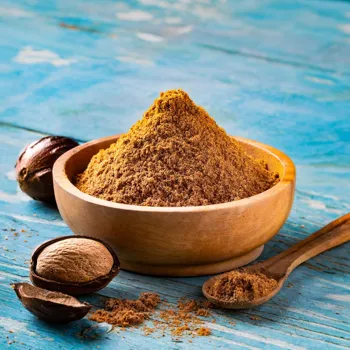
In Gujarati cuisine, for instance, many dals and vegetable preparations have a subtle sweetness that balances the sourness of tomatoes or tamarind and the heat of spices.
The addition of a small amount of jaggery can mellow out the sharpness of other flavors, creating a more rounded and palatable experience.
Similarly, in North Indian dishes like chana masala, a touch of sweetness from dried mango powder (amchur) can complement the spicy and tangy elements, adding a layer of intrigue to the dish.
This intelligent use of sweetness prevents dishes from becoming overly spicy or sour, ensuring a more balanced and enjoyable taste for everyone.
Sour elements in Indian cooking enhance taste, aid digestion
The sour element in Indian cooking is just as crucial, adding a refreshing tang that stimulates the appetite and cuts through richness. Common souring agents include tamarind, lemon juice, yogurt, kokum, and amla (Indian gooseberry). Each of these ingredients imparts a unique flavor profile.
Tamarind lends a characteristic tartness to South Indian dishes like sambar and rasam, while lemon juice brightens up North Indian curries and salads. Yogurt is used extensively in marinades and gravies, adding a creamy texture and a subtle sourness that tenderizes meat and balances the spices.
Kokum, popular in coastal regions, imparts a fruity and slightly tangy flavor to seafood curries and vegetable preparations. The clever use of souring agents not only enhances the taste but also aids in digestion.
The acid in these ingredients helps break down food, making it easier for the body to absorb nutrients.
Indian cuisine: Spice balance crucial for complex flavors
Spiciness, perhaps the most recognizable characteristic of Indian food, is achieved through a vast array of spices. Chili peppers, ginger, garlic, black pepper, and cloves are just a few examples of the ingredients that contribute to the characteristic heat.
However, the art of using spices in Indian cooking is not just about adding heat; it’s about creating a symphony of flavors that complements the sweet and sour elements. Different spices have varying degrees of pungency and complexity.
Some, like cardamom and cinnamon, add a warm and aromatic sweetness, while others, like cumin and coriander, provide earthy and citrusy notes. The key is to use spices judiciously, layering them to create a balanced and harmonious flavor profile.
Overdoing the chili peppers will create an overwhelming heat that masks other subtle tastes, while under-spicing will result in a bland and uninteresting flavor.
Mastering the art of balancing flavors in Indian cooking is key for a unique culinary experience
Ultimately, mastering the art of balancing sweet, sour, and spicy flavors in Indian cooking requires practice, experimentation, and a keen understanding of ingredients. There are many combinations that can be used , so be sure to experiment and find the right combinations.
Just like a painter mixes colors to create a masterpiece, an Indian cook combines flavors to create a culinary experience that is unique and memorable. The goal is not simply to create a dish that is palatable but to evoke emotions, memories, and a sense of cultural connection.
Whether it’s a simple daal or an elaborate biryani, the art of balancing flavors is the heart and soul of Indian cuisine.
It is a testament to the creativity and ingenuity of Indian cooks who have, for centuries, transformed humble ingredients into dishes that are loved and celebrated around the world. So step into your kitchen and start experimenting with these delicious flavors today!
AI Generated Content. Glance/InMobi shall have no liability for the content